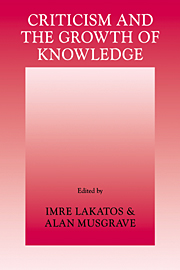 Criticism and the Growth of Knowledge
Criticism and the Growth of Knowledge Book contents
- Frontmatter
- Contents
- Preface
- Note on the Third Impression
- Logic of Discovery or Psychology of Research?
- Against ‘Normal Science’
- Does the Distinction between Normal and Revolutionary Science Hold Water?
- Normal Science, Scientific Revolutions and the History of Science
- Normal Science and its Dangers
- The Nature of a Paradigm
- Falsification and the Methodology of Scientific Research Programmes
- Consolations for the Specialist
- Reflections on my Critics
- Index
- References
The Nature of a Paradigm
Published online by Cambridge University Press: 05 August 2014
- Frontmatter
- Contents
- Preface
- Note on the Third Impression
- Logic of Discovery or Psychology of Research?
- Against ‘Normal Science’
- Does the Distinction between Normal and Revolutionary Science Hold Water?
- Normal Science, Scientific Revolutions and the History of Science
- Normal Science and its Dangers
- The Nature of a Paradigm
- Falsification and the Methodology of Scientific Research Programmes
- Consolations for the Specialist
- Reflections on my Critics
- Index
- References
Summary
1. The initial difficulty: Kuhn's multiple definitions of a paradigm.
2. The originality of Kuhn's sociological notion of a paradigm: the paradigm is something which can function when the theory is not there.
3. The philosophic consequence of Kuhn's insistence on the centrality of normal science: philosophically speaking, a paradigm is an artefact which can be used as a puzzle-solving device; not a metaphysical world-view.
4. A paradigm has got to be a concrete ‘picture’ used analogically; because it has got to be a ‘way of seeing’.
5. Conclusion: preview of the logical characteristics of a paradigm.
The purpose of this paper is to elucidate T. S. Kuhn's conception of a paradigm; and it is written on the assumption that T. S. Kuhn is one of the outstanding philosophers of science of our time.
It is curious that, up to now, no attempt has been made to elucidate this notion of paradigm, which is central to Kuhn's whole view of science as set out in his [1962]. Perhaps this is because this book is at once scientifically perspicuous and philosophically obscure. It is being widely read, and increasingly appreciated, by actual research workers in the sciences, so that it must be (to a certain extent) scientifically perspicuous. On the other hand, it is being given widely diverse interpretations by philosophers, which gives some reason to think that it is philosophically obscure.
- Type
- Chapter
- Information
- Criticism and the Growth of KnowledgeProceedings of the International Colloquium in the Philosophy of Science, London, 1965, pp. 59 - 90Publisher: Cambridge University PressPrint publication year: 1970
References
- 422
- Cited by


